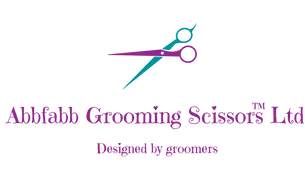What are the different parts of a dog grooming scissor?
When it comes to dog grooming, having the right tools is essential. One of the most important tools in a dog groomer's arsenal is the dog grooming scissors. But do you know the different parts that make up this essential tool?

- Finger Hole. This is the place where the fingers are place. Scissors have a ‘finger hole’ and a thumb hole’.
- Shaft or Handle. This area attaches the finger holes and pivot together. These can be straight or offset.
- Pivot or Tension Screw- This holds the blades together and play a vital role in the blades cutting action.
- Inner Blade- This is the side of the blades which physically touch as the blades close and open.
- Cutting Edge of the blade- This is the sharpest part of the blade with three different types of cutting edges.
- Ride Line- This is the smooth shiny line expanding across the edge of the inner blade.
- Point or Tip- This is the area where both blades meet when the blades are closed.
- Spine- This is the thickest part of the blade and the edge is rounded off and not sharp.
- Outer Blade. This is the side of the blade that shapes the scissors edge and can be made up of teeth if the scissor is a blender, thinner, chunker or texturising scissor.
- The Finger rings- A rubber or plastic ring which fits inside the finger and thumb hole to make the holes smaller to custom fit a hand.
- Stopper or Bumper. Rubber or plastic screw in insert that allows the scissor to close at the tip in the correct position and prevents the blades from crossing over.
- Half Moon- This is the area behind the pivot/tension screw and is a smooth area where the blades move over on another as the blades close.
- Logo- This indicates who made the scissor and can often includes model identification, size and steel used. This information however, can also be found in other scissors of the scissor.
- Finger Rest or Tang- This is the area where the 'pinky' finger rests and helps provide support and comfort whilst the dog groomer is holding and using the scissor. These rests can be fixed or removable.
The vital parts of a Dog Grooming Scissor.
Scissor Blades
The blades of a dog grooming scissors are the most crucial part. They are usually made of stainless steel for durability and sharpness. The blades come in various shapes and sizes, depending on the specific grooming task. Some scissors have straight blades, while others have curved or serrated blades for different cutting techniques. For more information on different cutting edge types, click here.
Scissor Handles
The handles of dog grooming scissors are designed for comfort and control. They are typically made from 440c Japanese Stainless Steel but they can be made from plastic or rubber. The finger holes are also located on the scissor's handles. The handles may also have ergonomic features to reduce hand fatigue during long grooming sessions. For more information on offset handles, please click here.
Tension Screw
A tension screw is a small screw, either raised or flat located between the handles of the scissors. This screw allows the dog groomer to adjust the tension between the blades if the blades feel too tight or loose. Proper tension is crucial for a smooth and precise cutting action and a dog groomer can manually check and adjust the tension if required. For more information on how to check and adjust the tension, click here.
Finger Rest
All dog grooming scissors have a finger rest, also known as a tang, located on one of the handles. The finger rest provides additional support and stability for the dog groomer's hand. It helps reduce strain on the fingers and allows for better control during grooming.
Finger Rings
Finger rings are the circular openings on the handles where the groomer inserts their fingers. They come in different sizes to accommodate various hand sizes. The finger rings should fit comfortably to ensure a secure grip and prevent slipping during grooming.
Bumpers or Stoppers
The bumper or stopper is an insert that sits on the thumb hole and is designed to allow the scissor to close at the top in the correct position. In doing so, the bumper/stopper prevents the blades from crossing over and damaging the cutting edges and performance of the scissor.
It is advised that a dog groomer regularly check that the bumpers are firmly in place and if loose, they can be manually screwed back in place. If left unchecked, the bumpers are liable to loosen, fall out and prevent the scissor from working correctly.
Types of Dog Grooming Scissors
There are different types of dog grooming scissors available, each designed for specific grooming tasks. Some common types include straight scissors, thinning scissors, curved scissors, and safety-tip scissors. Each type has its own unique features and benefits, catering to different dog grooming needs. To view the entire range of Abbfabb Grooming Scissors, please click here.
Conclusion
Understanding the different parts of a dog grooming scissors is essential for any pet owner or professional dog groomer. From the blades to the handles, each component plays a crucial role in achieving a well-groomed and happy pup. So, the next time you pick up a pair of dog grooming scissors, remember the importance of each part and how they contribute to a successful grooming session.



